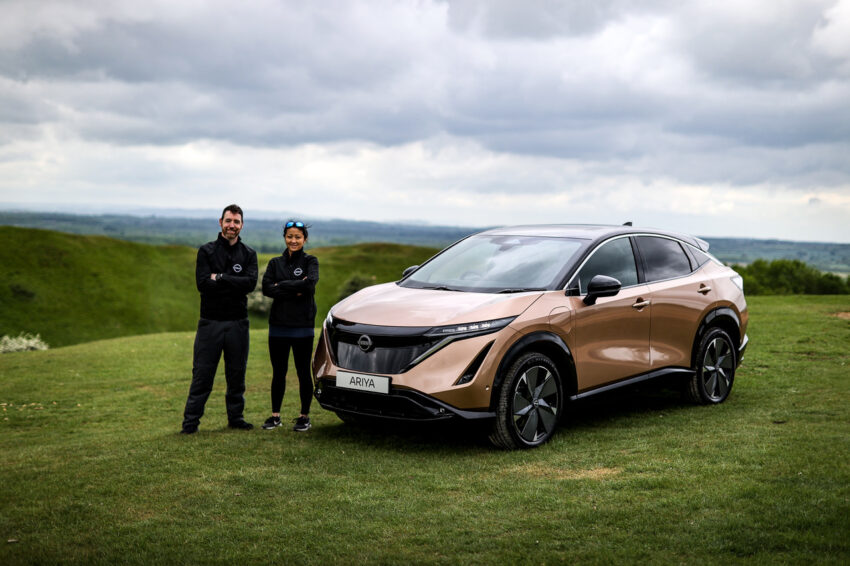Pole to Pole: The Epic EV Expedition
Back in April, husband and wife adventurers and EV advocates Chris and Julie Ramsey set off on their mission to travel from the magnetic North Pole to the South Pole in a fully electric vehicle.
In partnership with Nissan, the team will travel over 17,000 miles across several regions and continents with predicted temperatures ranging from -30⁰C to 30⁰C in a modified Nissan Ariya e-4ORCE.
We spoke to Chris and Julie one month into their expedition to discuss the inspiration behind the journey, the toughest challenges they’ve faced so far, and how this trip can inspire others to make the switch to electric vehicles!
Q: How has the journey been so far?
JR: We’ve been on this journey for about a month. We’ve come from the extreme cold and the harsh weather conditions up in the North, at –39, and now we’re in the plus twenties. We’ve gone from the two extremes, and it’s been absolutely incredible.
CR: The expedition is planned to take ten months. That’s not anything to do with driving an EV, charging infrastructure or anything like that; we have to travel in the arctic in March/April time which we were, and we can’t go into Antartica until December. We’re effectively chasing the summers between the two regions. We’re limited by the times we can go in, so it’s only ten months because of those factors. It means we get around eight months in between to explore the countries, the continents, the people, the cultures and all these amazing electric vehicle projects.
JR: To visit all these individuals, communities and projects, and to learn what’s happening out there and to shine a spotlight on these people that are doing good in the world and taking action and contributing to the climate change problem that we’re having today.

Q: How did you get into these mammoth expeditions?
CR: It started by accident, pretty much, like a lot of things in life. We’re both from Aberdeen in Scotland and I was working in my office one day, looking at the renewable energy side of my company I worked at, and the Nissan Leaf had popped up, and I thought “electric cars? Those things that won’t go very far, there are no chargers,” and I was curious. I borrowed one from my local dealer and drove around the whole of the UK for a long weekend and had an absolute nightmare because there were like 60 chargers in the country at the time. I shared that one social media and that’s how the journey began. It became a hobby for a while, doing these weird and wonderful adventures.
We did the Mongol Rally in 2017 and we drove a 30kW Nissan Leaf from London to Southern Siberia. 10,000 miles and 56 days. Still came back married, which is what people think is probably the biggest achievement.
JR: There were a lot of people that doubted us back then and we didn’t know ourselves. No one had driven a car further than their local town or village, so to take it from Aberdeen to Southern Siberia was a mammoth challenge back in 2017, where from Turkey onwards there was no public charging infrastructure. We had a hoot. We had a great adventure. We succeeded, we got there. We got to the finishing line and had a huge party.
CR: From Turkey onwards, we just used our two-pin charging kit and went up to people and asked them if they’d be kind enough to plug us in. We’re always powered by the kindness of people.
JR: I think electric vehicle adventuring is a unique type of adventuring because it forces you to stop, it forces you to charge and then forces you to interact with people, and that’s the unique thing about this journey is that if we were doing it in a normal combustion engine vehicle, you would just fill up and off you go, but the car really is connecting us with the with people, with communities and we’re meeting people every day. We’re sharing our stories every day, we’re chatting to people every day and we’re absolutely loving it.
Q: How has the car been modified for this trip?
CR: If you got into our
, you wouldn’t know it was any different. The interior is all the same, the actual stock car hasn’t been changed. The battery, the drivetrain and the suspension on the car is stock. It’s the same as what comes from the factory. We handed the car over to Arctic Trucks who do Arctic expeditions, and they modify the cars as well. The idea behind it was how can we make these 39-inch wheels fit the car without creating too much increase in height and keeping that centre of gravity, so we’ve got good weight displacement on the car. All the engineering work has gone into redesigning the wheel arch areas to allow the car to accommodate those tyres.
There’s a skid plate underneath to protect the battery and we have hitch points. The main function of those is to be able to Jack up the car at any angle, so you can jack up just the left-hand side to replace a left tyre, for example. Obviously if we get stuck in deep, thick snow, which we did on occasions, the support vehicle is able to then pull us from that that point, again at any angle. They serve a multi-purpose, so that was the only other major modifications made, because that’s going to be attached obviously to the chassis of the vehicle. Outside of that, it’s a regular Ariya.

Q: What have been some of the biggest challenges you’ve faced so far?
CR: There’s been many. Up in the Arctic, when we talk about these towns like Cambridge Bay, Yellowknife, for a lot of people, they won’t probably get the perspective of it. But if people go into Google Maps and look at Cambridge Bay and then Yellowknife, there’s a huge, vast landscape of Northern Canada there and all that exists is basically a barren bit of land with lakes in between, and that, I’d say, probably one of our one of biggest challenges is fact that we’ve had to traverse that land. Crossing mountains, valleys, gullies, rock field rock, boulder fields, you name it. We’ve crossed it and no vehicle ever goes there. Nobody in Canada travels that that section. That’s been a huge, huge challenge.
JR: We had challenges charging the battery to full in the extreme cold. The car charged, but it just charged very slowly, and I don’t think we ever reached 100%. In the extreme cold, we got maybe 50, 60%. The cold was always going to impact the battery and the charging, and that was the whole point of this project, to test that and see how we can overcome that.
Q: Where do you go from here? What does the rest of the expedition look like?
CR: From here (Vancouver) we head into North America and we’ve got quite a few engagement projects in North America with schools and some partners and various other projects going on there. From there, we pick up the Panamerican Highway in Mexico and travel through Central America. Pretty much every country in Central America we’ll travel through, so Guatemala, Honduras, Costa Rica, Panama. Then we drop into South America, and we stick to the West Coast. There are many, many highlights along that way until we get down to Ushuaia for the southern tip of Argentina. We crossed the Rockies here in Canada, which was just a stunning drive to do and then we’re going to cross the Andes in Chile, into Argentina. When we hit Ushuaia, we then look across to Antarctica. It’s going to be another amazing nine months.
JR: We hope to inspire others to look at our journey and show them how exciting electric vehicle adventuring can be and the good it can do in the world.
Q: What would your message be to someone who doesn’t believe in electric vehicles?
CR: From my perspective, it’s always been to not diss the technology until you’ve tried it. I still am a petrol-head in the sense that I still appreciate them, but it’s just saying give the technology a try, you will be surprised. The objection about driving long journeys? We take things to the extreme, so we’ve proved that long journeys are possible, whether you’ve got charging infrastructure or you don’t. Think about your daily life. Until I did this, I probably did one long journey a year, maybe every two years, so the reality is the car will do what you need it to do. If you do need that long journey and you’re still not convinced, then that ‘once a year’ just hire a car.
JR: We can we understand that EVs are not for everybody’s lifestyles. It all really depends on each individual and their personal circumstances. But I do feel that if 99% of your driving is within the city or your small town, then give it a go. We have lots of friends and family who have switched to EVs and they love it and wouldn’t go back, so just give it a try.







